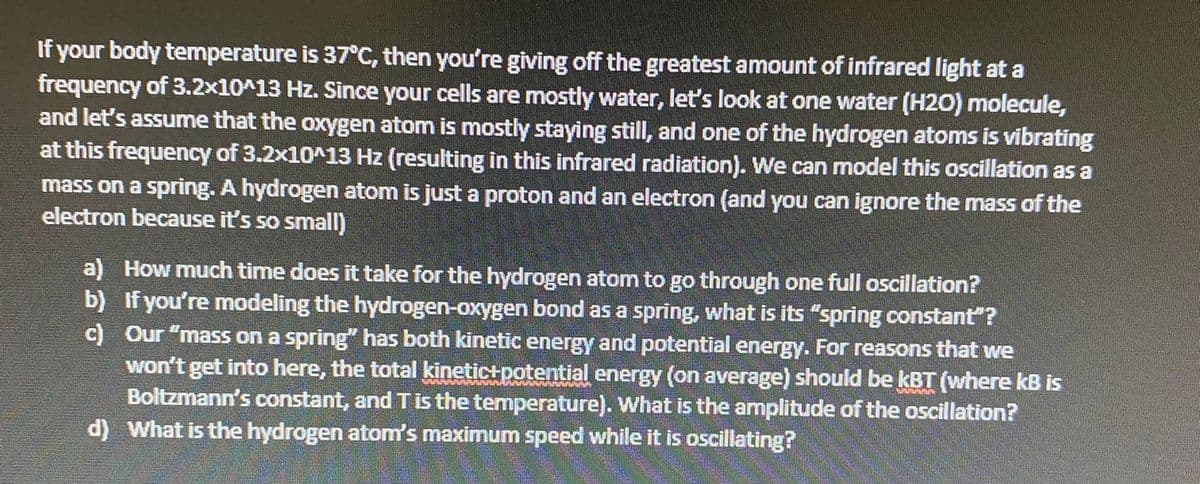If your body temperature is 37°C, then you're giving off the greatest amount of infrared light at a frequency of 3.2x10^13 Hz. Since your cells are mostly water, let's look at one water (H2O) molecule, and let's assume that the oxygen atom is mostly staying still, and one of the hydrogen atoms is vibrating at this frequency of 3.2x10^13 Hz (resulting in this infrared radiation). We can model this oscillation as a mass on a spring. A hydrogen atom is just a proton and an electron (and you can ignore the mass of the electron because it's so small) a) How much time does it take for the hydrogen atom to go through one full oscillation? b) If you're modeling the hydrogen-oxygen bond as a spring, what is its "spring constant"? c) Our "mass on a spring" has both kinetic energy and potential energy. For reasons that we won't get into here, the total kinetictpotential energy (on average) should be kBT (where kB is Boltzmann's constant, and T is the temperature). What is the amplitude of the oscillation? d) What is the hydrogen atom's maximum speed while it is oscillating?
If your body temperature is 37°C, then you're giving off the greatest amount of infrared light at a frequency of 3.2x10^13 Hz. Since your cells are mostly water, let's look at one water (H2O) molecule, and let's assume that the oxygen atom is mostly staying still, and one of the hydrogen atoms is vibrating at this frequency of 3.2x10^13 Hz (resulting in this infrared radiation). We can model this oscillation as a mass on a spring. A hydrogen atom is just a proton and an electron (and you can ignore the mass of the electron because it's so small) a) How much time does it take for the hydrogen atom to go through one full oscillation? b) If you're modeling the hydrogen-oxygen bond as a spring, what is its "spring constant"? c) Our "mass on a spring" has both kinetic energy and potential energy. For reasons that we won't get into here, the total kinetictpotential energy (on average) should be kBT (where kB is Boltzmann's constant, and T is the temperature). What is the amplitude of the oscillation? d) What is the hydrogen atom's maximum speed while it is oscillating?
Physics for Scientists and Engineers: Foundations and Connections
1st Edition
ISBN:9781133939146
Author:Katz, Debora M.
Publisher:Katz, Debora M.
Chapter34: Maxwell’s Equations And Electromagnetic Waves
Section: Chapter Questions
Problem 76PQ
Related questions
Question
100%

Transcribed Image Text:If your body temperature is 37°C, then you're giving off the greatest amount of infrared light at a
frequency of 3.2x10^13 Hz. Since your cells are mostly water, let's look at one water (H20) molecule,
and let's assume that the oxygen atom is mostly staying still, and one of the hydrogen atoms is vibrating
at this frequency of 3.2x10^13 Hz (resulting in this infrared radiation). We can model this oscillation as a
mass on a spring. A hydrogen atom is just a proton and an electron (and you can ignore the mass of the
electron because it's so smnall)
a) How much time does it take for the hydrogen atom to go through one full oscillation?
b) If you're modeling the hydrogen-oxygen bond as a spring, what is its "spring constant"?
c) Our "mass on a spring" has both kinetic energy and potential energy. For reasons that we
won't get into here, the total kinetictpotential energy (on average) should be kBT (where kB is
Boltzmann's constant, and Tis the temperature). What is the amplitude of the oscillation?
d) What is the hydrogen atom's maximum speed while it is oscillating?
Expert Solution
This question has been solved!
Explore an expertly crafted, step-by-step solution for a thorough understanding of key concepts.
This is a popular solution!
Trending now
This is a popular solution!
Step by step
Solved in 5 steps

Knowledge Booster
Learn more about
Need a deep-dive on the concept behind this application? Look no further. Learn more about this topic, physics and related others by exploring similar questions and additional content below.Recommended textbooks for you

Physics for Scientists and Engineers: Foundations…
Physics
ISBN:
9781133939146
Author:
Katz, Debora M.
Publisher:
Cengage Learning

Physics for Scientists and Engineers: Foundations…
Physics
ISBN:
9781133939146
Author:
Katz, Debora M.
Publisher:
Cengage Learning